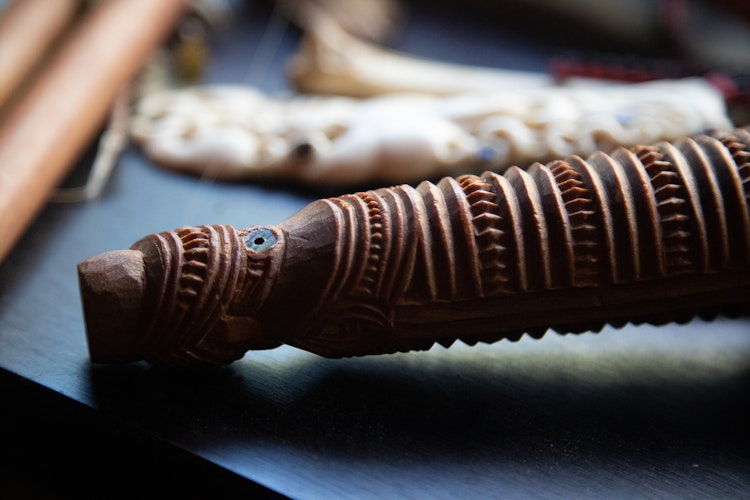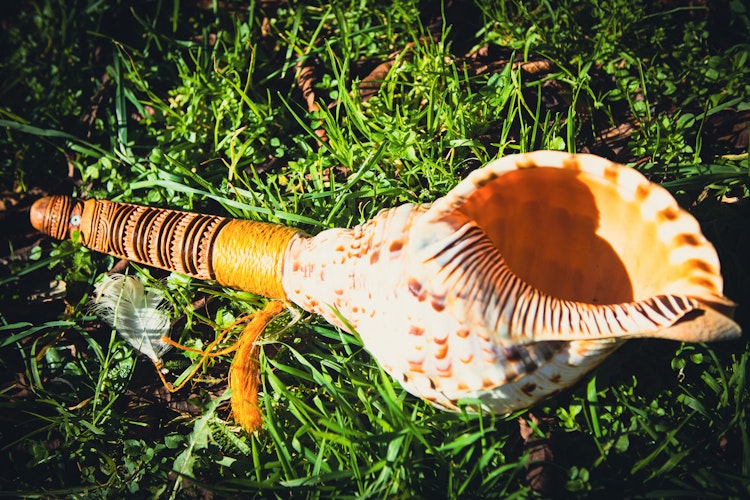

Museum of New Zealand Te Papa Tongarewa
In this text, Tāmihana Kātene (Ngāti Toa Rangatira, Ngāti Tama, Ngāti Koata, Te Taoū - Ngāti Whātua) talks about his dedication to taonga puoro, and how he, through pūrākau, research, and deep dives into archival collections, is bringing these historical objects back into the cultural practices of his people.
Tihei Mauri Ora! I breathe and there is life!
For the last 20 years, I have been involved in the reinvigoration of taonga puoro within the Wellington region in Aotearoa/New Zealand. As a carver of wood, stone, and bone, I have spent this time focusing on the study and recreation of traditional taonga puoro, with the intent of reintroducing and strengthening their use within traditional Māori cultural practice.
This focus has led me on a search for reference materials for both the physical aspects of taonga puoro as well as their use as tools in the implementation of Māori cultural philosophy. The aesthetic and physical attributes of our taonga are easily referenced by studying the examples contained in our nation’s museums. Access to these examples has been very difficult in the past. But as the focus of national museums, archives, and their staff shifts towards a more restorative approach to ancient knowledge, in recent times, this access has been encouraged, and is crucial to understanding the function and form of our taonga.
I am currently recreating a select-few taonga from the contact period1 that are held in the collections at Te Papa Tongarewa (Te Papa). As a part of my research fellowship through Victoria University of Wellington, this study is focused on recreating these taonga in order to understand the complex form and decoration that was applied by our tūpuna (Ancestors). This type of exploration would not be possible without the access provided by Te Papa and the enthusiastic support of their Māori staff.2


Pūtōrino:
In our cultural practices, there are approximately 44 individual types of taonga puoro. Of this list of 44, the Pūtōrino is the only taonga puoro that is uniquely attributed to Māori. It has been categorised by early colonial writers such as Elsdon Best as a “compromise instrument”: a poor flute and a poorer trumpet. This is the perspective of someone who is viewing the taonga through an alien lens with very little knowledge of its rich history and cultural significance.
In our Pūrākau (Stories) the pūtōrino takes its physical shape from the cocoon of the native case or bag moth (Oeceticus omnivorous). Its function is also explained through these pūrākau which speak of the voices that are generated when combined with human breath. These voices are:
Te Wai ō Hine - The Song of Hine (the divine feminine)
Te Kōkiri Haemata - The call of the Masculine
Te Ororuarangi - The combination and balance of the two previous voices
Our atua (divine entity) that we attribute this story to is named Hineraukatauri. She loved her Pūtōrino so much that she made it her home. This story explains the journey of Hineraukatauri and her search for a mate through song. She sings, he answers, and the combining of their essence is what creates their uri (descendants).
I must mention here that Māori are a people of iwi and hapū (or tribes). Each may have their own specific pūrākau which speaks of their own unique traditions.
Through my learning practice in creating these taonga, I have been influenced by many other carvers and makers. This led me to believe that Pūtōrino were, for the most part , large imposing taonga that captured the attention of the audience through the aesthetic. My study, through viewing examples in the collections, has completely contradicted this earlier train of thought. In viewing the form and proportion of items in the archival collections, I have found that some were large, but the majority are not. I find my approach in recent times has shifted focus to the “apparently” insignificant, small, humble taonga that are made to sing.
Pūtōrino from the collection of Museum of New Zealand Te Papa Tongarewa.
Image 1: Te Huringa, New Zealand, maker unknown. Purchased 2006. (ME023815).
Image 2: 1700-1770, New Zealand, maker unknown. Gift of Lord St Oswald, 1912. (ME010950).
Image 3: New Zealand, maker unknown. Gift of Lord St Oswald, 1912 (ME002502).
Image 4: maker unknown (WE001768)
My interaction with the museums and archives has been imperative in maintaining the mana (prestige/integrity) of my practice and my view of taonga puoro. As with all things, change is inevitable. Within the modern practice of Māori art, influences are taken from many external places and slowly, over time, our cultural traditions suffer for it.
When this happens, we forget our histories, we forget our pūrākau, and we forget the reasons why taonga puoro were made the way they were. Every shape, every form, every pattern has a purpose.
At this point of my journey, I find that it is my personal responsibility to remind makers and players and also budding practitioners that there are reasons for everything our tūpuna did. Innovation within our practices is a wonderful thing, as long as it has a strong foundation in our traditions. Studying examples of their work ensures this. Without access to these examples, like many of our ancestors' great works... we would be lost.
Me hoki whakamuri, kia aro whakamua.
To see our path forward we must look to the past.



